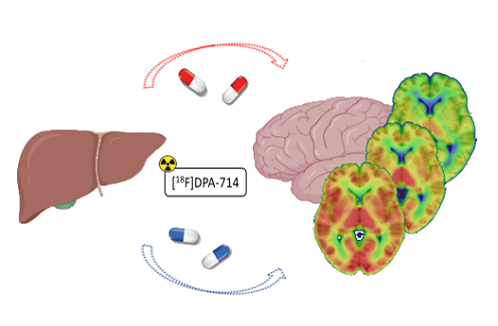The neuroinflammatory processes associated with neurodegenerative disorders such as Alzheimer's, Parkinson's and multiple sclerosis are still relatively poorly understood. PET imaging enables us to study these phenomena in patients, by monitoring the overexpression of the 18 kDa translocator protein TSPO by brain immune cells (microglia and astrocytes), activated during these inflammatory processes. To date, the preferred TSPO ligand for PET imaging of neuroinflammation is [18F]DPA-714; however, little is known about the fate of this radiotracer in the body and the various parameters likely to modify its metabolism after injection into the patient.
In this study, investigators evaluated the effect of several factors, such as age, gender, body mass index (BMI), TSPO polymorphism and drug treatments on [18F]DPA-714 metabolism and/or plasma concentration, which could lead to bias in the quantification and interpretation of PET images. In 201 patients and healthy volunteers who had participated in SHFJ PET imaging protocols with [18F]DPA-714 (brain and whole body), the authors measured the residual (non-metabolized) fraction of the radiotracer and its venous plasma concentration. In subjects treated with drugs capable of modulating the activity of the enzyme responsible for [18F]DPA-714 metabolism, an increase (inhibiting drugs such as metformin, nicardipine, sartans, etc.) or decrease (inducing drugs such as carbamazepine) in the residual fraction and plasma concentration of the radiotracer has been observed. In the brain, failure to take account of inter-individual variations in metabolism due to drug treatments can lead to a bias of around 30% in the measurement of parameters for quantifying neuroinflammation (radiotracer distribution volumes). Other factors such as age, gender, BMI and TSPO polymorphism, which modifies the affinity of the radiotracer for its target, may also impact the metabolism and/or plasma concentration of [18F]DPA-714 and need to be taken into account.

MA Peyronneau © BioMaps - SHFJ / CEA
In conclusion, this study demonstrates the importance, when analyzing patient imaging data, of taking into consideration measures of individual metabolism and/or radiotracer concentration, which may affect the input function of [18F]DPA-714 and, consequently, its cerebral and peripheral uptake. In summary, individual input functions should be preferred to mean input functions derived from healthy controls.
Contact : Marie-Anne Peyronneau marie-anne.peyronneau@cea.fr
The 18 kDa translocator protein (TSPO), a mitochondrial protein with numerous physiological functions, is ubiquitously expressed in peripheral tissues, but is only found in low quantities in normal brain, whereas it is overexpressed in activated microglia, in regions of brain inflammation resulting from neurological and neurodegenerative disorders. TSPO is now recognized as a specific tracer of neuroinflammation in brain PET imaging.